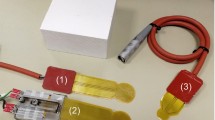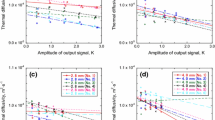Abstract
The transient plane source (TPS) technique, also referred as the Hot Disk method, has been widely used due to its ability to measure the thermal properties of an extensive range of materials (solids, liquids, and powder). Recently, it has been recognized that typical Hot Disk sensors can influence TPS results of thermally insulating materials and lead to an overestimation of thermal conductivity. Although improvements have been proposed, they have not yet been implemented in the commercial TPS, leaving researchers with non-standardized modifications or options provided by a commercial Hot Disk apparatus. An empirical study of thermally insulating materials such as extruded polystyrene (XPS) and aerogel blanket is conducted in order to address the factors that affect the reliability of thermal conductivity k obtained using the commercial TPS apparatus. Sensor size, input power, duration of the measurements, applied pressure, and, in the case of anisotropic materials, heat capacity are investigated, and the results are compared with those using a Heat Flow Meter apparatus. The effect of sensor size on the k value is ascribed to heat loss through connecting leads and is more pronounced in smaller sensors and in materials with lower k values. In the case of XPS and aerogel, the effect becomes minimal for sensors with a radius r ≥ 6.4 mm. The low input power yields a high scattering of the results and should be avoided. Applied contact pressure and the tested region of the specimen play an important role in experiments with low-density fibrous materials due to the large percentage of heat being transferred by radiation and the heterogeneous nature of the samples, respectively. Additionally, the sensitivity of anisotropic measurements to the value of the material’s volumetric heat capacity (ρCp) is shown, emphasizing the need for the precise determination.





Similar content being viewed by others
6. References
ASTM C518-17, Standard Test Method for Steady-State Thermal Transmission Properties by Means of the Heat Flow Meter Apparatus (ASTM International, West Conshohocken, 2017)
ASTM C177-19, Standard Test Method for Steady-State Heat Flux Measurements and Thermal Transmission Properties by Means of the Guarded-Hot-Plate Apparatus (ASTM International, West Conshohocken, 2019)
ASTM E1461-07, Standard Test Method for Thermal Diffusivity by the Flash Method (ASTM International, West Conshohocken, 2007)
D.G. Cahill, R.O. Pohl, Thermal conductivity of amorphous solids above the plateau. Phys. Rev. B 35, 4067–4073 (1987)
ASTM C113/C1113M-09, Standard Test Method for Thermal Conductivity of Refractories by Hot Wire (Platinum Resistance Thermometer Technique) (ASTM International, West Conshohocken, 2019)
ISO 22007-2:2015, Plastics—Determination of Thermal Conductivity and Thermal Diffusivity—Part 2: Transient Plane Heat Source (Hot Disc) Method (International Organization for Standardization, Geneva, 2015)
S.E. Gustafsson, Transient plane source techniques for thermal conductivity and thermal diffusivity measurements of solid materials. Rev. Sci. Instrum. 62, 797–804 (1991)
M. Gustavsson, E. Karawacki, S.E. Gustafsson, Thermal conductivity, thermal diffusivity, and specific heat of thin samples from transient measurements with hot disk sensors. Rev. Sci. Instrum. 65, 3856–3859 (1994)
T. Log, S.E. Gustafsson, Transient plane source (TPS) technique for measuring thermal transport properties of building materials. Fire Mater. 19, 43–49 (1995)
V. Bohac, M.K. Gustavsson, L. Kubicar, S.E. Gustafsson, Parameter estimations for measurements of thermal transport properties with the hot disk thermal constants analyzer. Rev. Sci. Instrum. 71, 2452–2455 (2000)
H. Zhang, M.-J. Li, W.-Z. Fang, D. Dan, Z.-Y. Li, W.-Q. Tao, A numerical study on the theoretical accuracy of film thermal conductivity using transient plane source method. Appl. Therm. Eng. 72, 62–69 (2014)
M. Ahadi, M. Andisheh-Tadbir, M. Tam, M. Bahrami, An improved transient plane source method for measuring thermal conductivity of thin films: Deconvoluting thermal contact resistance. Int. J. Heat Mass Transf. 96, 371–380 (2016)
S.A. Al-Ajlan, Measurements of thermal properties of insulation materials by using transient plane source technique. Appl. Therm. Eng. 26, 2184–2191 (2006)
S. Flueckiger, T. Voskuilen, Y. Zheng, T.E. Pourpoint, Advanced Transient Plane Source Method for the Measurement of Thermal Properties of High Pressure Metal Hydrides, in: ASME 2009 Heat Transfer Summer Conference collocated with the InterPACK09 and 3rd Energy Sustainability Conferences: Heat Transfer in Energy Systems; Thermophysical Properties; Heat Transfer Equipment; Heat Transfer in Electronic Equipment, 2009, vol. 1, pp. 215–221.
R.J. Warzoha, A.S. Fleischer, Determining the thermal conductivity of liquids using the transient hot disk method. Part I: establishing transient thermal-fluid constraints. Int. J. Heat Mass Trans. 71, 779–789 (2014)
R.J. Warzoha, A.S. Fleischer, Determining the thermal conductivity of liquids using the transient hot disk method. Part II: establishing an accurate and repeatable experimental methodology. Int. J. Heat Mass Trans. 71, 790–807 (2014)
M. Gustavsson, S.E. Gustafsson, On the use of transient plane source sensors for studying materials with direction dependent properties, in: R. Dinwiddie, R. Mannello (eds.) 26th international thermal conductivity conference/14th international thermal expansion symposium, vol. 26, Cambridge, MA, 2005, pp. 367–377.
B. Wicklein, A. Kocjan, G. Salazar-Alvarez, F. Carosio, G. Camino, M. Antonietti, L. Bergström, Thermally insulating and fire-retardant lightweight anisotropic foams based on nanocellulose and graphene oxide. Nat. Nanotechnol. 10, 277–283 (2015)
D. Wu, R. Fu, Requirements of organic gels for a successful ambient pressure drying preparation of carbon aerogels. J. Porous Mater. 15, 29–34 (2008)
C. Scherdel, R. Gayer, T. Slawik, G. Reichenauer, T. Scherb, Organic and carbon xerogels derived from sodium carbonate controlled polymerisation of aqueous phenol-formaldehyde solutions. J. Porous Mater. 18, 443–450 (2011)
J. Feng, J. Feng, C. Zhang, Thermal conductivity of low density carbon aerogels. J. Porous Mater. 19, 551–556 (2012)
Y. Liu, Z. Chen, J. Zhang, S. Ai, H. Tang, Ultralight and thermal insulation carbon foam/SiO2 aerogel composites. J. Porous Mater. 26, 1305–1312 (2019)
R. Coquard, E. Coment, G. Flasquin, D. Baillis, Analysis of the hot-disk technique applied to low-density insulating materials. Int. J. Therm. Sci. 65, 242–253 (2013)
H. Zhang, Y. Jin, W. Gu, Z.-Y. Li, W.-Q. Tao, A numerical study on the influence of insulating layer of the hot disk sensor on the thermal conductivity measuring accuracy. Prog. Comput. Fluid Dyn. 13, 191–201 (2013)
P. Johansson, B. Adl-Zarrabi, C.-E. Hagentoft, Using transient plane source sensor for determination of thermal properties of vacuum insulation panels. Front. Arch. Res. 1, 334–340 (2012)
A. Elkholy, H. Sadek, R. Kempers, An improved transient plane source technique and methodology for measuring the thermal properties of anisotropic materials. Int. J. Therm. Sci. 135, 362–374 (2019)
H. Zhang, Y. Li, W. Tao, Effect of radiative heat transfer on determining thermal conductivity of semi-transparent materials using transient plane source method. Appl. Therm. Eng. 114, 337–345 (2017)
S. Fantucci, A. Lorenzati, G. Kazas, D. Levchenko, G. Serale, Thermal energy storage with super insulating materials: a parametrical analysis. Energy Procedia 78, 441–446 (2015)
T. Li, J. Song, X. Zhao, Z. Yang, G. Pastel, S. Xu, C. Jia, J. Dai, C. Chen, A. Gong, F. Jiang, Y. Yao, T. Fan, B. Yang, L. Wågberg, R. Yang, L. Hu, Anisotropic, lightweight, strong, and super thermally insulating nanowood with naturally aligned nanocellulose. Sci. Adv. 4, 3724 (2018)
Y. He, Rapid thermal conductivity measurement with a hot disk sensor: Part 1. Theoretical considerations. Thermochim. Acta 436, 122–129 (2005)
C.M. Pelanne, Heat flow principles in thermal insulations. J. Therm. Insul. 1, 48–80 (1977)
ASHRAE, Chapter 26: heat, air, and moisture in building assemblies—material properties, in: 2017 ASHRAE Handbook—Fundamentals (ASHRAE, 2017), pp. 26.21–26.23.
G. Chaykovskiy, Comparison of Thermal Insulation Materials for Building Envelopes of Multi-storey Buildings in Saint-Petersburg (Mikkeli University of Applied Sciences, Mikkeli, 2010)
S. Schiavoni, F. D’Alessandro, F. Bianchi, F. Asdrubali, Insulation materials for the building sector: a review and comparative analysis. Renew. Sustain. Energy Rev. 62, 988–1011 (2016)
Rigid Polystyrene Foam (EPS, XPS), Technical data sheet. https://products.basf.com. Accessed 26 Nov 2019.
Acknowledgements
The authors would like to thank Dr. Mattias Gustavsson (Hot Disk AB) and Dale Hume (Thermtest Inc) for their technical discussions. This work was funded by the Building Technologies Office, Office of Energy Efficiency and Renewable Energy (EERE) of the US Department of Energy under Contract No. DE-AC05-00OR22725 with UT Battelle, LLC.
Author information
Authors and Affiliations
Corresponding author
Additional information
Publisher's Note
Springer Nature remains neutral with regard to jurisdictional claims in published maps and institutional affiliations.
Rights and permissions
About this article
Cite this article
Trofimov, A.A., Atchley, J., Shrestha, S.S. et al. Evaluation of measuring thermal conductivity of isotropic and anisotropic thermally insulating materials by transient plane source (Hot Disk) technique. J Porous Mater 27, 1791–1800 (2020). https://doi.org/10.1007/s10934-020-00956-3
Published:
Issue Date:
DOI: https://doi.org/10.1007/s10934-020-00956-3




